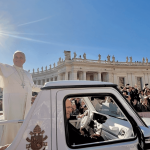King Charles III has approved the Canadian government’s new heraldic Royal Crown design that swaps out its crowning cross for a snowflake and replaces other crosses with maple leaves.
The Canadian Royal Crown redesign was recommended by Canadian Prime Minister Justin Trudeau and is based on the bejewelled St. Edward’s Crown used at King Charles’ May 6 coronation as well as the slightly different Tudor Crown symbol.
However, the stylized Canadian emblem drops the crosses and fleurs-de-lis on these crowns, instead incorporating “elements emphasizing the Canadian identity of the monarchy,” the Governor-General of Canada’s website says in its heraldry section.

The Canadian Royal Crown emblem is “an important symbol of the sovereign’s authority, the Canadian monarchy, and the power of the state acting in the sovereign’s name,” according to the office of the governor general of Canada, who represents King Charles III in his role as king of Canada.
“In place of the orb and cross at the top of the crown is a stylized snowflake, a reference to Canada being a northern realm,” says the governor general’s website. The snowflake symbol is linked to the insignia of the Order of Canada, a top Canadian honour.
Christian royalty has long used the combined orb and cross atop King Charles’ crown as a reminder that the world is subject to the dominion of Jesus Christ. The symbol is part of the coronation regalia of the British monarchy.
In the Church of England coronation liturgy, the Archbishop of Canterbury Justin Welby gave King Charles an ornate handheld orb and cross and told him, “Receive this orb, set under the cross, and remember always the kingdoms of this world are become the kingdoms of Our Lord, and of his Christ.”
Christian iconography sometimes shows Jesus Christ holding the orb and cross.
King Charles’ official emblem, which uses the Tudor Crown, is ringed by crosses and fleurs-de-lis symbols. The Canadian design, however, replaces these symbols with maple leaves. The governor general’s website described the maple leaf as “a quintessential Canadian symbol used extensively since the 19th century to represent Canada and all its citizens.”
The Royal Crown is a restricted emblem in Canada. Any new use requires special permission from the reigning British monarch. Canadian government agencies of the federal and provincial governments may seek permission to use it, as may law enforcement bodies at the federal, provincial, and municipal levels.
“In general, it will be used as part of emblems of sovereignty (such as Royal Cyphers and the coats of arms of the country and the provinces), honours insignia, badges of the Canadian Armed Forces, badges of law enforcement bodies, and the heraldic emblems of entities with a significant tie to the monarchy,” the governor general’s website says.
The emblem is also used for commemorative purposes.
King Charles approved the change in April on the advice of the Canadian government. The designer is Cathy Bursey-Sabourin, who serves as Fraser Herald of Arms and principal artist at the Canadian Heraldic Authority.
The decision brought criticism from many, both for the process used to make the changes as well as for the new symbols.
Writing in The National Post, Father Raymond J. de Souza said, “For a government that lives intensely in the present tense, to crown Canada as a snowflake nation seems to ignore how the word is actually now used.”
Catholic News Agency with B.C. Catholic files



